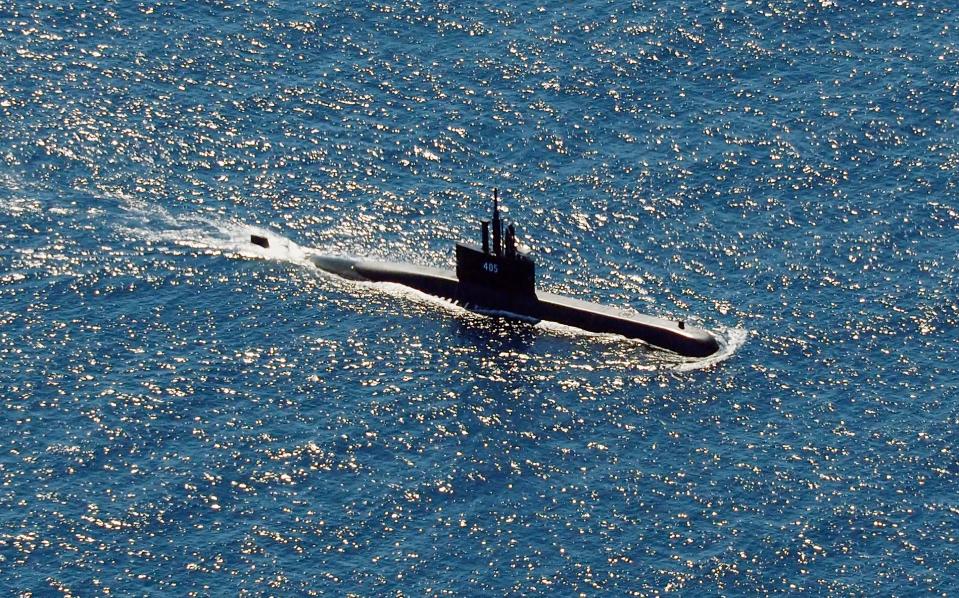Missing submarine: What we know about race to rescue stricken sailors off Bali

Authorities are in a race against time to rescue the 53-man crew from an Indonesian submarine that disappeared without a trace two days ago.
The KRI Nanggala 402, a 1,395-tonne vessel built in Germany, went missing during a torpedo drill on Wednesday off the resort island of Bali.
President Joko Widodo has asked Indonesians to pray for the crew’s safe return as rescue teams frantically search the waters for signs of the missing submarine.
The Independent has compiled everything you need to know about the missing vessel.
What happened to the submarine?
There is no definitive explanation yet as to what happened with the missing underwater craft. However the Indonesian navy has said an electrical failure could have left the vessel unable to execute emergency procedures to resurface.
The navy thinks that the submarine sank to a depth of between 2,000-3,000 feet, which is much deeper than its collapse depth -the depth at which water pressure would be greater than the hull could withstand.
The submarine’s collapse depth was estimated at 655 feet by a South Korean company that refitted the vessel in 2009-2012.
Admiral Yudo Margono said an oil slick - which has been the focus of searches on Friday - in the area could could have spilled from a crack in the submarine‘s fuel tank or the crew could have released fuel and fluids to reduce the vessel’s weight so it could surface.
However there is still no conclusive evidence the oil slick was from the missing submarine.
Who has joined the search?
Currently the Indonesian military said there are more than 20 navy ships, two submarines and five aircraft scouring the area for signs of the missing underwater craft.
A number of countries have offered assistance as locating the crew becomes ever more critical. Rescue ships from neighbouring Singapore and Malaysia are expected to arrive between Saturday and Monday.
An Australian warship equipped with a sonar device and a helicopter was set to arrive later Friday and the US is sending aircraft to help with the search.
Germany, France, Russia, India, Turkey and South Korea have also offered assistance.
What challenges does the rescue team face?
Frank Owen, secretary of the Submarine Institute of Australia, has warned that the submarine could be at too great a depth for a rescue team to operate.
“Most rescue systems are really only rated to about 600 meters (1,970 feet),” he said. “They can go deeper than that because they will have a safety margin built into the design, but the pumps and other systems that are associated with that may not have the capacity to operate. So they can survive at that depth, but not necessarily operate.”
Mr Owen, a former submariner who developed an Australian submarine rescue system, said the Indonesian vessel was not fitted with a rescue seat around an escape hatch designed for underwater rescues.
He added that the submarine could be recovered from 500 meters (1,640 feet) without any damage but couldn’t say if it would have imploded at 700 meters (2,300 feet).
Australian Defence Minister Peter Dutton told Sydney Radio 2GB that the fact that the submarine is “in a very deep part of waters” makes it “very difficult for the recovery or for location.”
How much oxygen do the crew have?
Indonesian navy chief General Achmad Riad said that the submarine is expected to run out of oxygen in the next 24 hours.
He told reporters on Friday: “We will maximise the effort today, until the time limit tomorrow (of) 3am.”
There have been no signs of life from the submarine, but the spokesperson refused to speculate on its fate.
What has the Indonesian government said?
President Joko Widodo has asked Indonesians to pray for the crew’s safe return, while ordering all-out efforts to locate the stricken submarine.
He said in a televised address: “Our main priority is the safety of 53 crew members. To the family of the crew members, I can understand your feelings and we are doing our best to save all crew members on board.”
Additional reporting by agencies
Read More
Indonesia submarine: 72 hours to find lost vessel – but it may be too deep to retrieve

 Yahoo Finance
Yahoo Finance 